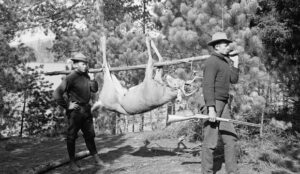I once was tasked with the job of moving a heavy, bulky object. I forget what it actually was. It may have been a chest of drawers or a heavy cathode-ray TV. I asked a colleague to assist me. Moving the item proved to be much easier than I anticipated, so much so I felt I had wasted my colleague’s time. He wisely replied “Two men can carry a piano. One man cannot carry half a piano.”
Yesterday I was reading an article that asserted that because of heavy weapons such as the 50lb Javelin ATGW the weight carried by modern soldiers was unlikely to decrease in the near future. There then followed proposals for high-tech solutions such powered exo-skeletons and cargo carrying robots that would follow a soldier like ducklings.
Why carry such things on a soldier’s back? Why not use a light handcart. Granted, a handcart cannot be used on all types of terrain so it would also need provision for being picked up and carried when necessary. Following such trains of thought I came across this webpage.
As the author notes, carrying poles are seldom used in the west except when hunters wish to carry a kill.

The ironic thing is those same two hunters probably walked into the woods sweating and carrying heavy backpacks. The idea of using a pole to carry those probably never occurred to them.
Carrying poles are still widely used in the east. Here are two interesting scientific papers on their use:
An interesting image. Western depictions of sedan chairs show the porters carrying the entire weight in their hands. If you think about it that seems rather unlikely and some form of strap or harness seems more likely. Note that in the illustration below of the stretcher the man at the rear is using a sling to take some of the weight. The Chinese sedan chair pictured uses two short poles to allow the load to be spread between four and their shoulders rather than their hands used.


If you are on your own, a carrying pole can still be used if your load can be divided. There are lots of images of heavy and/or bulky loads being carried by single individuals with carrying poles, but the one below is probably my favourite.


Another way to carry a heavy load with a pole was the roman furca. Apparently the real name was “aerumnula” but Roman soldiers preferred to call it by the same name as the structures criminals were crucified on. The furca is often described as a “forked stick” but in actuality was two sticks bound in a “T” shape, the longer being about four feet. A furca could probably be used as a support to rig a makeshift shelter.



Generally the furca is shown carried rather like a hobo’s pole. The website below explains how the system is more comfortable if used in conjunction with the shield and cloak. The Roman soldier carried a similar weight to that of many modern soldiers. Unlike an overloaded rucksack the furca could be quickly discarded in the event of an ambush. The same is true of other loads carried by pole.

